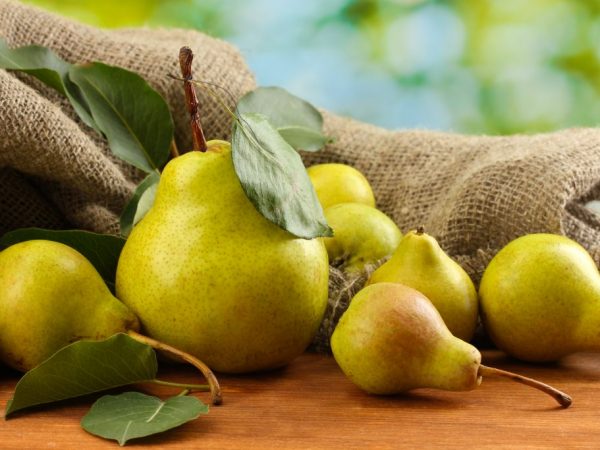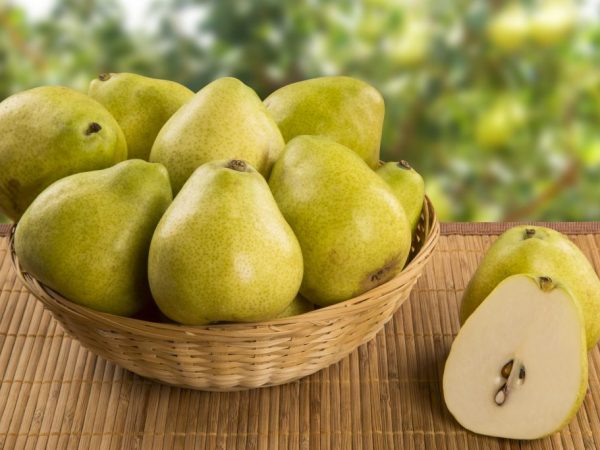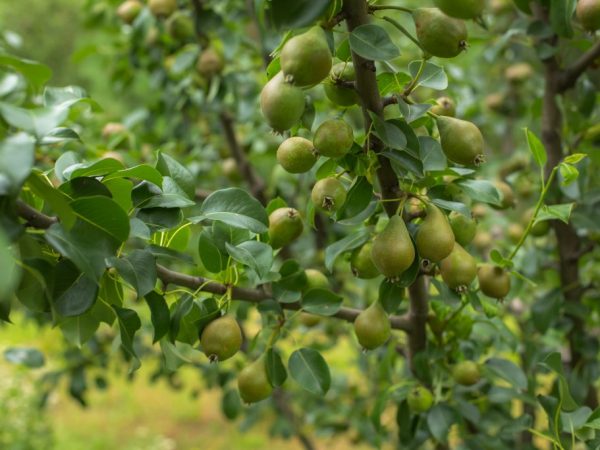Characteristics of the rich pear variety
Pear Rich is a winter variety of pears. Unpretentious in care with a high level of productivity. In the article, we will consider a detailed description of the variety, planting rules and care recommendations.

Characteristics of the rich pear variety
Characteristics of the variety
Pear Rich bred in Chelyabinsk, suitable for growing in the northern regions. Well tolerates winter. Even at a temperature of -30 ° C, it does not freeze.
According to the description of the variety, the Rich pear annually gives a large harvest. Up to 40-50 kg of fruit can be harvested from one tree.
Harvested in autumn, mid-October - early November. The fruits can be stored in a cool place for up to 3 months.
Description of the tree
Medium-sized trees of the Bogataya pear variety have a semi-spreading crown. The average height reaches 8-10 m. It needs to be formed from the second year of planting a seedling in a permanent place.
The tree is self-pollinated. Begins to bear fruit from 4-5 years of planting seedlings.
Description of fruits
The fruits of the Rich pear are large. On average, they weigh more than 150 g. Some fruits reach 220-240 g in weight.
According to the description, they have the following characteristics:
- round form;
- the color of ripe pears is yellow, sometimes with a red barrel;
- sweet, impatient taste;
- white pulp.

Description of fruits
The fruits of this variety do not need ripening. Perfect for preservation. The fruit of the Rich variety pear produces an excellent, slightly sour wine. Often used in fruit cuts or smoothies.
How to plant a pear
The first important step is to determine the water table and soil type before planting. The pear does not like excess moisture.
The root system can rot, the tree can start to ache and then die. It is best when the water is located at a depth below 6-8 m.
Choosing a landing site
The landing site should be well lit and protected from winds. It is desirable that the soil is loose. This is necessary to ensure sufficient air delivery to the roots.
Pear Rich prefers slightly acidic soil with little sand and clay. The abundance of calcium in the soil negatively affects the taste and formation of fruits. Calcium stones and granules begin to form in the pulp.
Sapling selection
The second stage is the selection of a seedling. When selecting, gardeners are advised to adhere to the following principles:
- The seedlings must be healthy and young. The ideal age for a seedling is 1-2 years.
- Annual seedlings should be no higher than 120 cm.For two-year-old seedlings, the height of the trunk should be about 40-60 cm, and the length of the main branches should be 20 cm.
- Examine the seedlings carefully for pests.
Before planting, you need to keep the tree for 2-3 hours in a bucket of water. This will help him quickly adapt to new growing conditions.
Planting a seedling
When planting, make sure that the size of the hole corresponds to the size of the root system. It is important that the planting stake, treated from rotting from the underside, is driven into the ground by at least 0.5 m.It is necessary to pour humus and peat into the pit.
The seedling must be placed on the top of the mound and carefully spread the roots along the slopes. It is necessary to fill up the seedling and the hole in such a way that the root collar is above the ground, otherwise the tree may die.
To avoid deformation, the tree must be tied to the stake in several places. After planting, the tree must be watered with 20-30 liters of water. You can also pour over a solution of lime at the rate of 300 g of lime per bucket of water.
Care
Crown formation and pruning
Correct crown formation will provide a good skeletal base for the tree. This will create the correct distribution of nutrients, air circulation, and balanced fruit formation. Provides proper lighting, increases the convenience of spraying and harvesting.
First you need to decide on the main skeletal branches. This will be the central trunk and additional largest branches extending from it.

Pear care
There are several techniques for the formation of skeletal branches: tilt, shortening and bending.
- For shortening, the upper branches of the tree must be pruned. This will slow down the growth of the tree and encourage horizontal growth of the branches. For five-year-old plants, it is recommended to shorten the central trunk at about 3 m.
- Tilt and bend are recommended for those branches that already have some natural bend.
- It is important to remove unnecessary branches from the tree. All branches that go across or in depth must be cut. This treatment allows you to increase air exchange in the crown. This will reduce the likelihood of diseases of fruits, leaves and the tree itself.
Also, trees are rejuvenated every 5 years. Remove old, dead branches. Diseased branches are removed, capturing 20-30 cm of the healthy part.
Watering
The tree requires regular watering, but in small amounts. Watering should be carried out strictly according to a specific schedule:
- when buds open (May);
- 10 days after flowering (June);
- during the period when the fruits are poured (early-mid July);
- when the tree begins to shed its leaves (early October).
For seedlings, 3-4 liters of water are enough. The volume of water required for adult pears is 7 buckets per tree.
Loosening
Loosening is carried out several times a year during irrigation and supply of various fertilizers to the root.
If the soil is not loosened, the growth of pears will slow down, and nutrients will cease to flow.
Top dressing and weed removal
The introduction of dressings and various fertilizers is needed to regulate acidity. Mineral and organic fertilizers are applied mainly in spring.
Ammonium nitrate, urea can also be added in the summer in the morning. It is needed to improve flowering.
Pests and diseases
Despite the fact that the rich pear is resistant to various diseases, improper care can cause pest infestation.
A pear of this variety can be susceptible to leafy gall midge. It is a small insect up to 2-3 mm in size. Causes great harm to seedlings, because feeds on young, green leaves. Insecticides will help get rid of leaf gall midge.
Other pests that can harm the plant include:
- gall mites;
- fruit gall midges;
- moths;
- honeycloths.
You can avoid their appearance by providing proper care for the pear. It is necessary to remove fallen leaves on time and check the condition of the tree once a week - examine the leaves, bark, branches, fruits.
Conclusion
The pear of the Bogataya variety is distinguished by its high resistance to frost. Its fruits are versatile in use. Correct and timely care will prevent the appearance of pests.


